The Invisible Killer

Last year, a new report laid one in 10 deaths at the feet of an invisible killer: Air pollution.
News headlines highlighted the top findings – that 3300 New Zealanders die prematurely every year due to air pollution – for a day or two. Then we moved on, as if we hadn’t just unmasked one of the country’s greatest mass killers.
Air pollution is a murder mystery in reverse.
We know who the killer is, even if we can’t see him. The victims, however, are faceless. We can rigorously estimate their number, where they lived, even the source of the dirty air that cut their lives short, but we don’t know any of their names.
It’s a public health crisis, taking more lives even than Covid-19 in the past year, mounting a death toll 10 times greater than the number of people who die on our roads annually, though the latter garners far more attention.
It’s harder to write about an invisible killer than it is to cover a devastating car accident or a high-profile murder.
Even though we know what’s responsible, there’s no murder weapon at the scene, no suspect to catch on the run. Instead, to understand the crime and how to prevent it continuing, we must track microscopic particulate matter, thinner than a human hair, as we breathe it in, as it enters our bloodstream, as it turns our immune system against us – as it kills us.
There are still uncertainties in this space. But one thing we do know is that air pollution is a solved problem. We already have the technology to eliminate the generation of these dangerous particles. We just lack the will to do something about it, because it’s so much easier to ignore an invisible killer than to put its killing spree to an end.
Chronic exposure

One of the greatest uncertainties, says Otago University environmental epidemiologist Simon Hales, is that we still don’t understand all the ways air pollution kills us.
“The most honest answer is that we still don’t really know. And we certainly don’t know in the sort of detail that we would like to know.”
He compares it to smoking regularly. That process brings on a range of symptoms, including a smoker’s cough, a sore throat, dry eyes and other hallmark signs of inflammation.
Within the body, the immune system is turning on itself – defensive cells rush to fight the exotic pollutants as they would a bacterium or virus. When that doesn’t work, they turn on the lungs or other nearby tissue, doing a little bit of damage.
One puff won’t kill you. But the long-term exposure, even at low levels, takes a cumulative toll on your body.
“Your body is reacting to the foreign substance and some of the toxic substances in cigarette smoke and it’s attempting to repair the damage by causing increased blood flow and a heightened immune response. Something similar to that is probably happening even at low levels of exposure to air pollution,” Hales explains.
Research has increasingly found the length of exposure is the most important factor in estimating damage from air pollution.
Short sharp spikes in dirty air can cause serious fallout. The five-day Great Smog of London killed an estimated 12,000 people in 1952 and short-term exposure to high levels of particulate matter during the 2020 Australian bushfire season is thought to have cut short 171 lives.
Those bushfires were felt in New Zealand too.
“It was raining ash in the middle of Sydney. I’m looking up and it’s grey in the middle of the day. It was like the apocalypse, it was just horrendous,” Gerda Kuschel, director of the environmental consultancy Emission Impossible and lead researcher on the Health and Air Pollution in New Zealand (HAPINZ) 3.0 study which made headlines in July 2022, tells Newsroom.
“The plume that came over from that, yes, it colours the sky. It also made our monitors go off scale. I’m horrified if we get an exceedance in New Zealand, 2300 kilometres away from a wildfire in Australia.”
Still, that impact pales in comparison to the grinding toll of daily inhalation of even low levels of dangerous substances. Australian studies have indicated around 5000 people die prematurely each year from air pollution – nearly 30 times more than were killed by the disastrous bushfire smoke.
“The World Health Organisation and everybody else says chronic exposure to low levels is really the one that starts to debilitate the population and cause issues around loss of life quality, increased morbidity through hospitalisation, restricted activity days, kiddies with asthma. Mortality is in there as well,” Kuschel says.
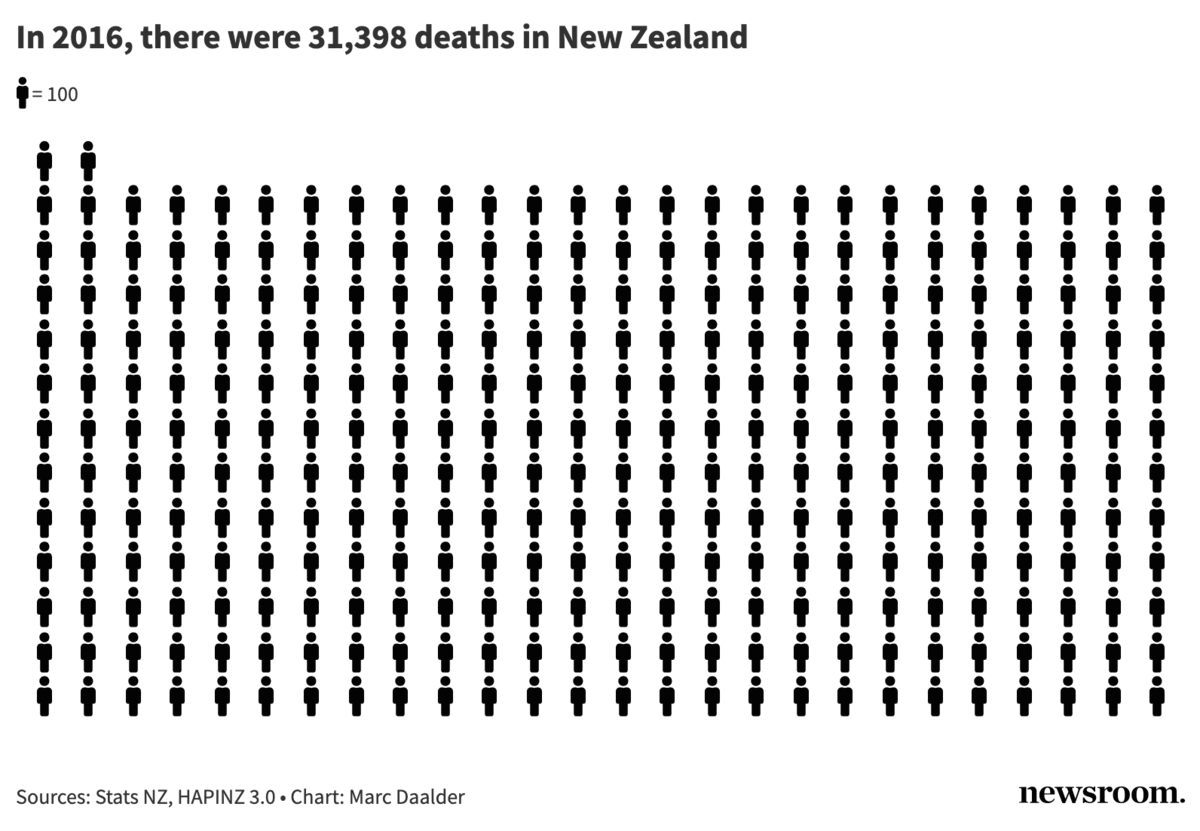
Cradle to grave
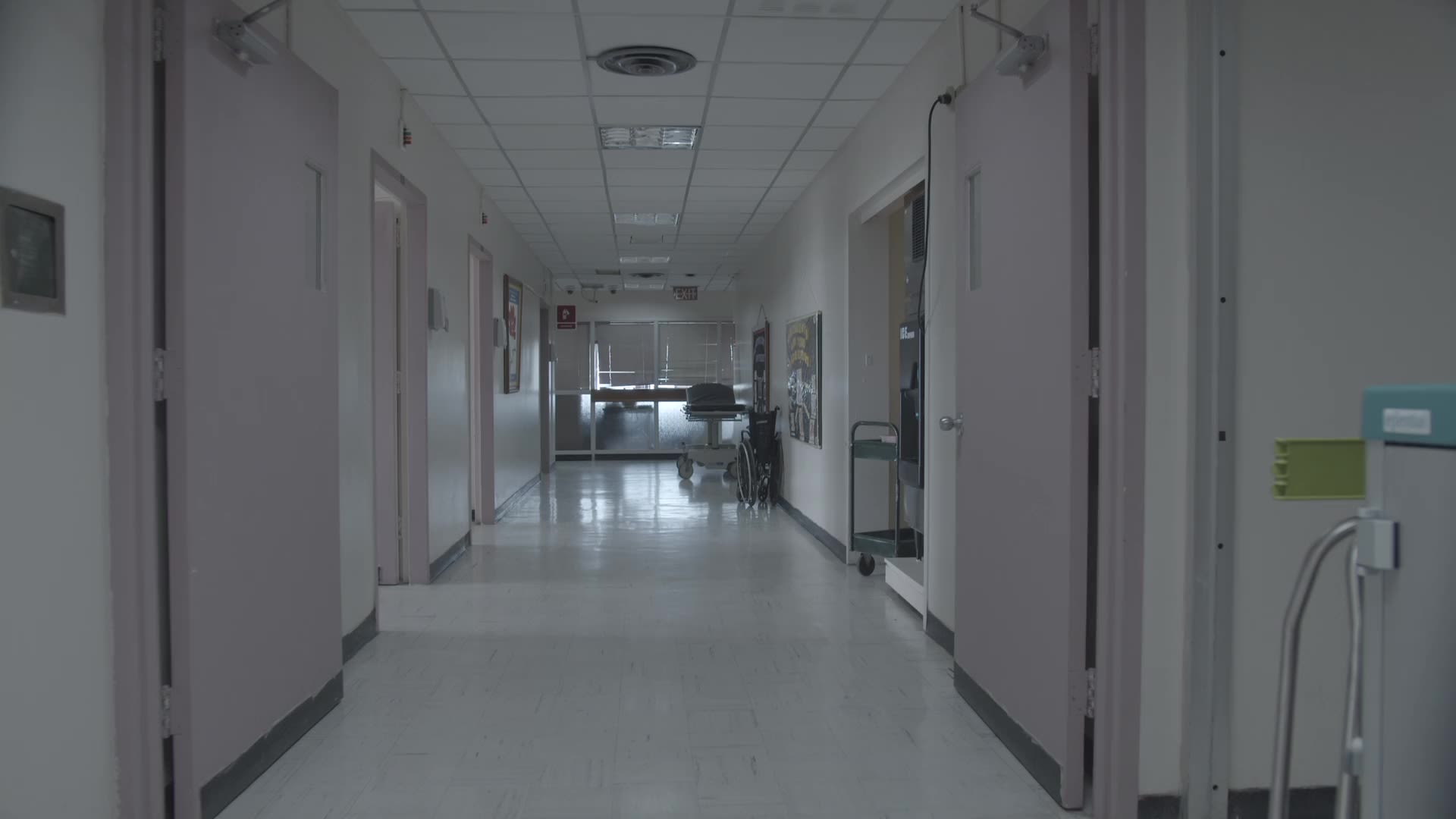
The insidious way air pollution makes its way into the rest of the body is another clue in the investigation to understand how it does so much harm.
“Supposing you’re in your car and you’re driving along behind a diesel truck, the sun is just setting and you can see the belching black smoke coming out the back. You’re inhaling some of that. Those tiny particles will stay inside your car for a long time after you’ve overtaken the truck,” Hales says.
“Some of them are so small that they actually can enter your bloodstream. They go into your lungs, they can actually cross the barrier between your body and the outside via the alveoli, little tiny air sacs where the exchange of oxygen occurs in your lungs. There, your body asks what is soot doing in the bloodstream, and you get this inflammatory response.”
After undertaking this respiratory journey, sooty particles have been found in a wide array of our organs.
It may be hard to imagine the scale of the intrusion these particles can have. But lead, which was once ubiquitous in petrol before being banned in 1996, offers a helpful comparator.
Blood lead levels in schoolchildren in Christchurch in 1985 were more than eight times higher than in school-aged children tested in 2014. Removing this harmful agent from petrol sparked a massive shift in the prevalence of the pollutant in our bloodstreams. Which makes you wonder – what about all the stuff that's still in petrol?
The process starts before birth. Several studies have found black carbon on the foetal side of the placenta and in blood samples from the umbilical cord of newborn babies.
Pregnant people living near heavy traffic in California were 10 percent more likely to have underweight babies and 80 percent more likely to have extremely premature babies. Miscarriage and infertility (in women and men) have also been linked to air pollution.
On the tail end of a lifetime, air pollution also takes its toll. MRIs taken of the brains of American women in their seventies and eighties showed even low levels of pollution were associated with shrinkage equivalent to a year or two of additional ageing. Elderly women who were exposed to higher levels of pollution also performed on cognitive tests as if they were two years older.
It’s no surprise, therefore, that dementia and Alzheimer’s have also been linked to pollution. Those outcomes might be formed at an early age – Mexican scientists conducted autopsies on children and young adults killed in car accidents and found the early markers of Alzheimer’s in the brains of 40 percent of those who lived in polluted areas but none of those who had lived in cleaner areas.
Then there’s everything in between. HAPINZ 3.0 tied air pollution in New Zealand to thousands of cases of a wide range of conditions in 2016 (the latest year for which data was available), including 13,200 cases of asthma, 4600 cardiovascular hospitalisations and 8500 respiratory hospitalisations.
There were 1.745 million restricted activity days – when people weren’t able to engage in their normal daily pursuits like work or school.
“You can think of it a bit like a pyramid, really. The tip of the pyramid is people dying as a result of acute or long-term exposure,” Hales, who worked on the HAPINZ study, says.
“Then there’s people who are admitted to hospital, people who might end up going to the doctor. And then a lot of people who aren’t sick enough to go to the doctor but aren’t able to work because they’ve got a respiratory infection or asthma or a cardiovascular problem. And then below that, people who have mild symptoms who can still do their normal activities but aren’t as well as they could be.”
Of course, neither nitrogen dioxide (NO2) nor fine particulate matter (PM2.5) are listed on death certificates. What does a death from air pollution actually look like?
“The list is getting longer by the day, really, of the mortality outcomes that we do associate with air pollution,” Hales says.
People usually think of respiratory diseases, like lung cancer. That’s certainly one outcome – about 15 percent of lung cancer cases in New Zealand occur in non-smokers and many of these could be due to air pollution. (By coincidence, Hales says, the original link between smoking and lung cancer was established by a British study that sought to understand the impacts of smog on cancer rates.)
By far the most common form of air pollution illness and death, however, is cardiovascular disease. That’s heart attacks and strokes, mainly.
In many of these cases, air pollution will have been one of several contributors. It was only in 2020 that particulate inhalation was even recognised on a death certificate anywhere in the world – and that came after an extended coronial inquiry in the United Kingdom.
Everyone dies, but air pollution and other factors change when they die. Average life expectancy in New Zealand is probably a couple of months lower than it would be without air pollution. That doesn’t sound like much, but it lands unevenly.
Some people will have their lives cut short by years, even decades. Others won’t experience much of an impact at all.
“To die as a result of long-term, lifetime exposure to air pollution, it’s not typically going to kill you in your twenties,” Hales says.
“But it will cause you to get gradually more sick more quickly than you otherwise would and then die of cardiovascular disease or respiratory disease that you would not otherwise have had, potentially months or years earlier than you would have died.”
And again, that’s just the tip of the pyramid – or the tip of the iceberg, you could say. There are still all the tens of thousands of non-fatal impacts of air pollution afflicting a far greater proportion of the population.

No safe levels
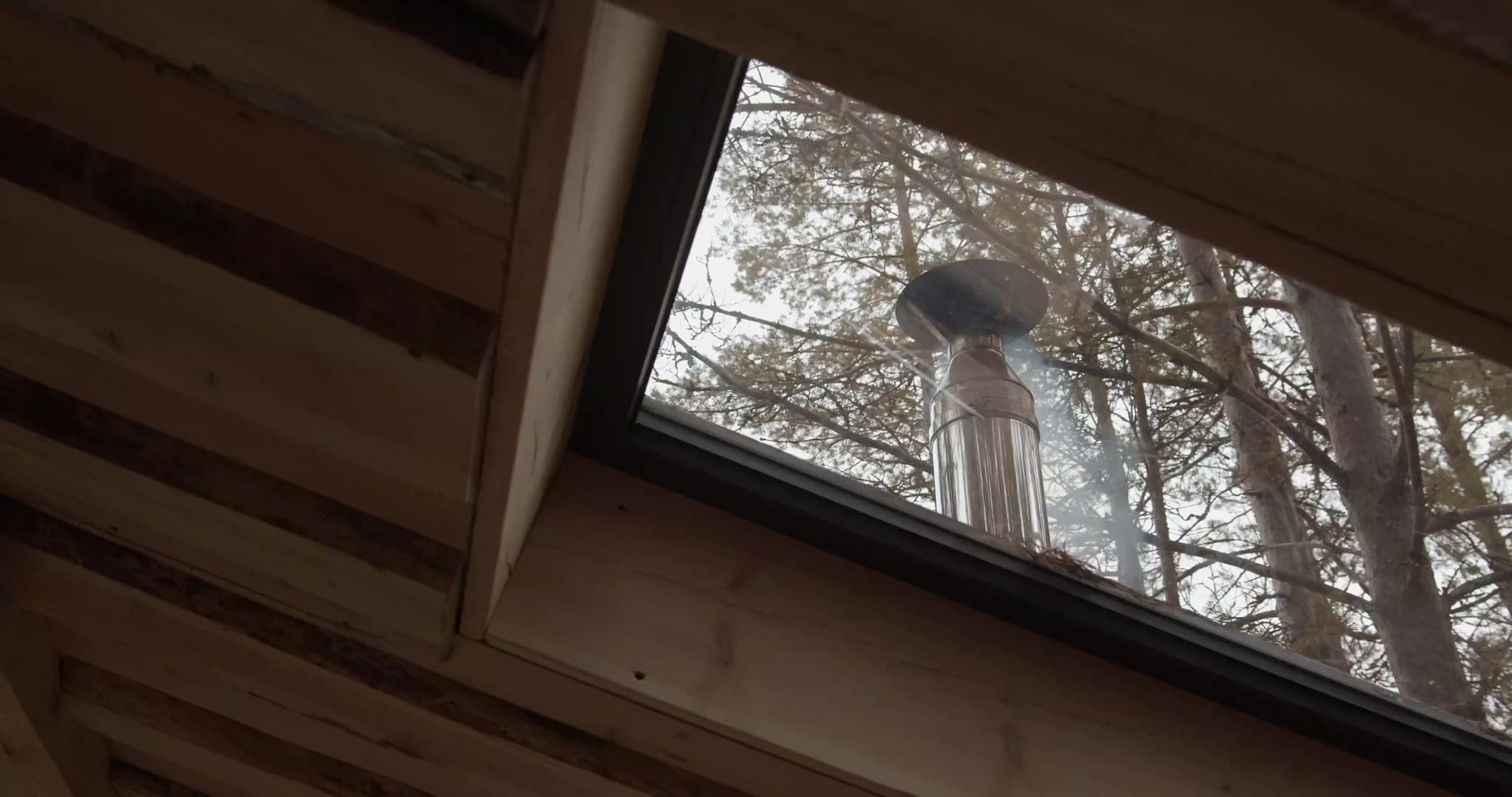
In fact, HAPINZ is one of a new wave of studies illustrating the wide range of impacts from chronic exposure to low levels of air pollution, from the fatal tip of the pyramid down to the gasping base.
When their results first came back, Kuschel asked overseas experts to check their work because they were so unbelievable.
Not only were significant health impacts coming from PM2.5, but the results indicated NO2 was a major killer and cause of childhood asthma cases. These were new findings, but they would soon be corroborated.
Since 2005, the WHO has said an annual exposure to more than 10 micrograms of PM2.5 per cubic metre of air is dangerous. A microgram is a million times smaller than a gram.
Under that measure, just 660,000 New Zealanders or 14 percent of the population lived in excess of the WHO guidelines in 2016.
In 2021, the organisation updated its advice. The “safe” level of PM2.5 was halved. NO2 exposure guidelines fell by 75 percent. This, combined with more research showing even miniscule levels of air pollution are dangerous and the positive feedback from overseas reviewers, helped Kuschel feel confident in the HAPINZ results.
“By the end of it, [our overseas reviewer] was asking to use our results to augment what they’re doing in Europe. And only in the last couple of months Canada has also released their study saying they found really strong effects of air pollution at low levels,” Kuschel says.
“Then, of course, we’ve been now vindicated by the World Health Organisation changing their guidelines. Never in my wildest dreams did I think they would take the PM2.5 annual guideline and say it was 10, we now think it should be five. And for NO2, it was 40 and we now think it should be 10. That is unheard-of but it is reflecting what researchers like us and other teams around the world are finding, that there is no safe threshold.
“You can’t un-know that. I mean, that is saying there is no safe level. Basically the guidelines are the level of risk we are prepared to accept from air pollution. There is no safe level.”
According to the new WHO metrics, for every four Olympic swimming pools' worth of air you breathe in, the amount of PM2.5 you inhale should take up less than space than a single green pea.
Unsurprisingly, four in every five New Zealanders are now exposed to these dangerous levels of PM2.5 each year. Chances are, you’re one of them.
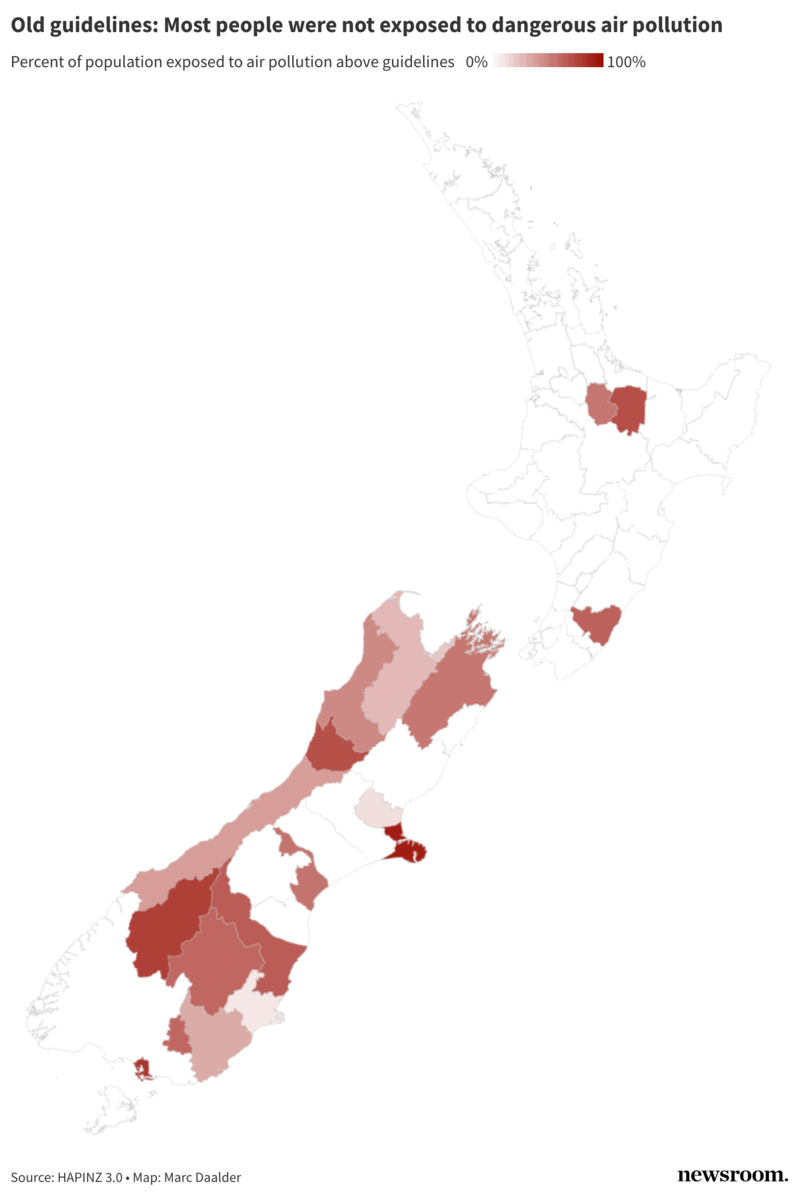
Where do these pollutants come from and how do we stop it?
Environmental journalist David Wallace-Wells summarised it simply but effectively in a recent essay on air pollution: Everything we burn, we breathe.
Combustion of petrol and diesel in vehicle engines produces nitrogen dioxide. Breathe in enough of it and it will kill you.
Firing wood (or, in some places, coal) to heat your home produces PM2.5, both inside and outside of the building. Breathe in enough of it and it will kill you.
Industry, too, has the potential to be a major source of particulate matter. Overseas, estimates indicate fossil fuel burning is responsible for eight million deaths each year. Although this includes vehicle fuel, it suggests one in every five people who die each year, globally, is a victim of fossil fuels.
In New Zealand, Kuschel says, the effect is more muted. We have high rates of renewable electricity and stringent regulations for industrial burning. Most industrial sites, like coal-fired milk drying facilities, are also far from heavily-populated areas.
According to HAPINZ, industry is responsible for just a handful of additional air pollution deaths and hospitalisations each year.
Even so, because air pollution is such a specific local issue, nationwide studies like HAPINZ can overlook the unique circumstances of some towns.
On Tuesday, RNZ reported on the situation in Mount Maunganui, where the port and big industrial facilities have rendered the local air dangerous. For years, monitors have detected levels of pollutants in excess of even the old, less stringent WHO standards.
A report commissioned by local public health officials found 13 deaths a year – or around 10 percent of the annual death toll – were attributable to the heavy industry.
Across the country, however, the most dangerous sources of air pollution are far more commonplace and diffuse.
For us, cars are the major problem. In particular, our addiction to diesel utes means our air pollution from transport is far greater than in developed countries which prefer petrol utes, like the United States.
Our penchant for older cars is also troublesome. The average age of a car in New Zealand, 14 years, is longer than the decade-long lifespan of the catalytic converters which filter many pollutants from exhaust fumes. Despite this, our WOF regulations don’t require any emissions safety testing unless fumes are more visible than usual.
Moreover, we only require imported vehicles to meet lax air pollution standards. New cars brought into New Zealand must meet the Euro 5 standard, while used vehicles are subject to the even less stringent Euro 4.
In the European Union, meanwhile, all vehicle imports have been subject to a much harsher Euro 6 limit since 2015.
All of this has come back to roost in our air pollution statistics. HAPINZ found nitrogen dioxide, which came solely from motor vehicles and disproportionately from diesel cars, was behind nearly two thirds of the premature deaths attributed to air pollution. Particulate matter from cars caused another 222 deaths as well.
The greatest source of PM2.5 in New Zealand comes from home fires – usually wood, in a handful of cases, coal. These particles disproportionately cause cardiovascular issues and restrict daily activities.
They’re also an issue of proximity. It’s the households who burn wood or coal and their neighbours who suffer the bulk of the consequences.
“There’s a lot of work saying that if you have a wood burner in your house, guess what? You’re fumigating your house with PM2.5 because it’s not perfectly hermetically sealed,” Kuschel says.
This points to a major consideration for air pollution, in contrast to other environmental issues like climate change: Its effects are very much localised.
Those who live closest to sources of pollution are most likely to experience its impacts. Overseas, air pollution exposure is divided along stark income and racial lines.
Here too, that phenomenon is visible. For every 1000 New Zealanders, 810 are currently exposed to PM2.5 above the new WHO guidelines and 314 are exposed to NO2 above those limits.
Māori, who live disproportionately rurally, are actually slightly less exposed to unsafe air than the average person. But the urban-dwelling Pasifika population is highly exposed, with 944 of every 1000 living with dangerous PM2.5 levels and 545 subjected to unsafe NO2 concentrations.
The localism of air pollution is an important part of peeling back the veil of its invisibility. We know what’s making us unhealthy – the motorway next door, the neighbourhood’s reliance on coal during frigid winters and so on.
It also makes it easier to inspire action than the global nature of climate change. Reducing emissions in New Zealand is important, but it has only a tiny impact on the global situation or even the frequency and intensity of extreme whether here. Slashing air pollution in your town, however, has immediate benefits for you and your family.
An offer we can’t refuse
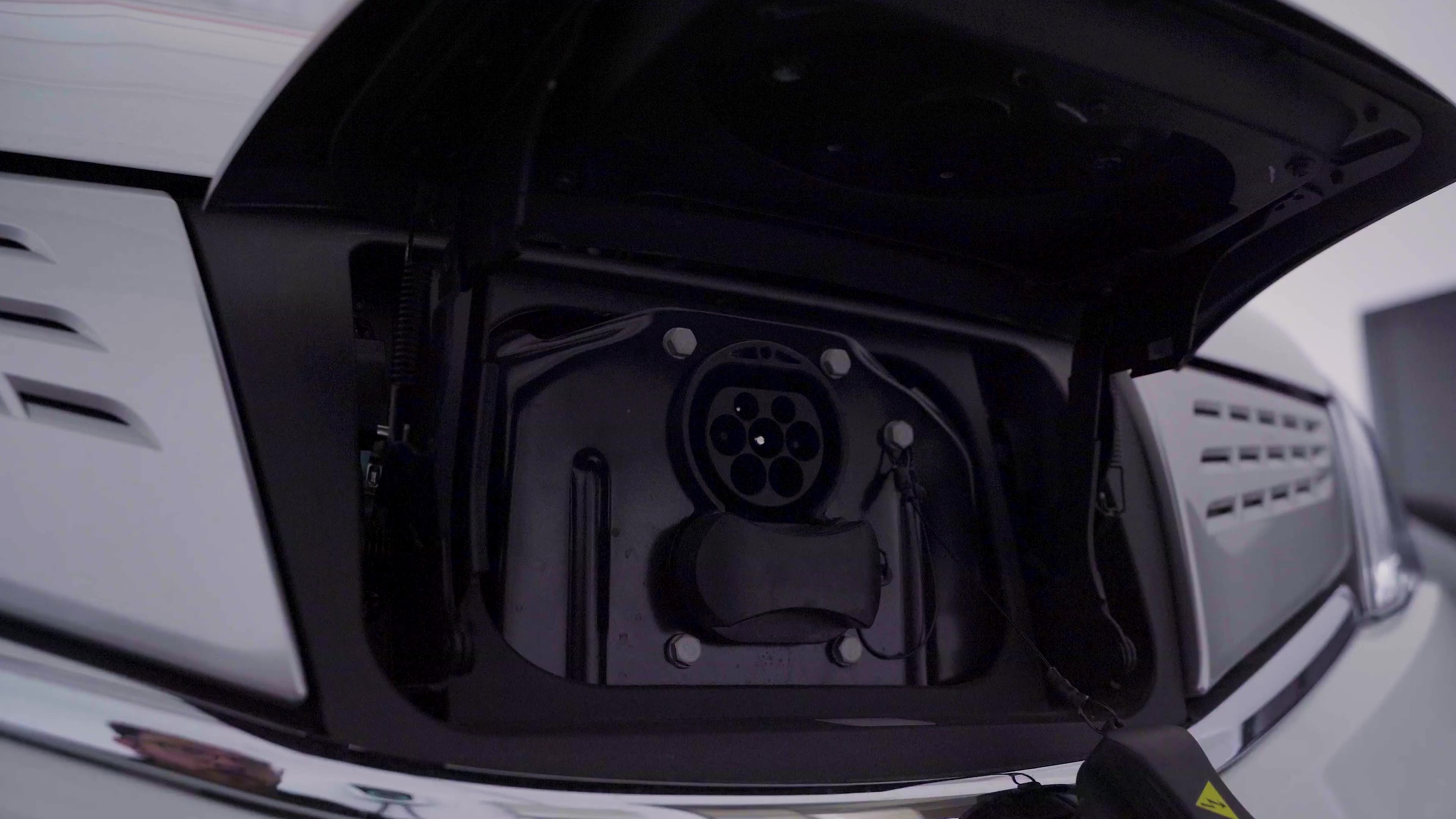
That’s particularly useful because the solutions to air pollution are very closely aligned with the solutions to climate change.
Getting people out of cars and electrifying the vehicles that remain won’t only slash greenhouse gas emissions, it could also prolong the lives of 2200 people each year and avert $10.5 billion in social costs.
Home heating is tougher. Wood burners are seen as a low-carbon alternative to gas heating. In 2018, half a million households – one third of all homes in the country – had a wood burner.
Earlier HAPINZ studies, in 2007 and 2012, focused on the impacts of wood burners and prompted stricter regulations. Under the National Environmental Standards (NES) for air quality, PM2.5 emissions from wood burners are heavily curtailed. But we now know even low levels of air pollution are dangerous over long periods of time – a fact the regulations have not yet been updated to account for.
Kuschel isn’t sure whether we’ll ever have wood burners that release no harmful emissions. But stricter regulations can continue to wind down the amount of PM2.5 (and slightly less harmful PM10) that fireplaces release each year.
We can also electrify home heating, using efficient heat pumps in new homes, especially in colder climes.
Like climate solutions, air pollution fixes can actually improve the way we live – we can boost health through active transport and cut power bills through efficient heating. The benefits of slashing air pollution extend beyond just stopping the problem, but that is a significant plus on its own too.
HAPINZ estimated the overall social cost of air pollution in 2016 at $15.6 billion or more than $3000 per person. While cost-benefit analyses of climate policies under past WHO standards have understated the benefits, Kuschel hopes the latest findings will be incorporated in the future.
A spokesperson for the Treasury said they would consult with the Ministry for the Environment on potentially including the HAPINZ findings in the analysis tool for Budget 2024. Agencies can also independently use different values in their own analyses.
“It does mean you can start looking at co-benefits with the HAPINZ results. If you do stuff cleverly you can get what I’m calling a trifecta of benefits, you can seriously improve your greenhouse gases, you can make sure you’re not going to make your harmful emissions any worse and if those things involve increasing activity levels, you get a plus,” Kuschel says.
“If you put all that stuff together, the argument is so blinking compelling. It’s a Godfather thing – an offer you can’t refuse.”
Wake-up call
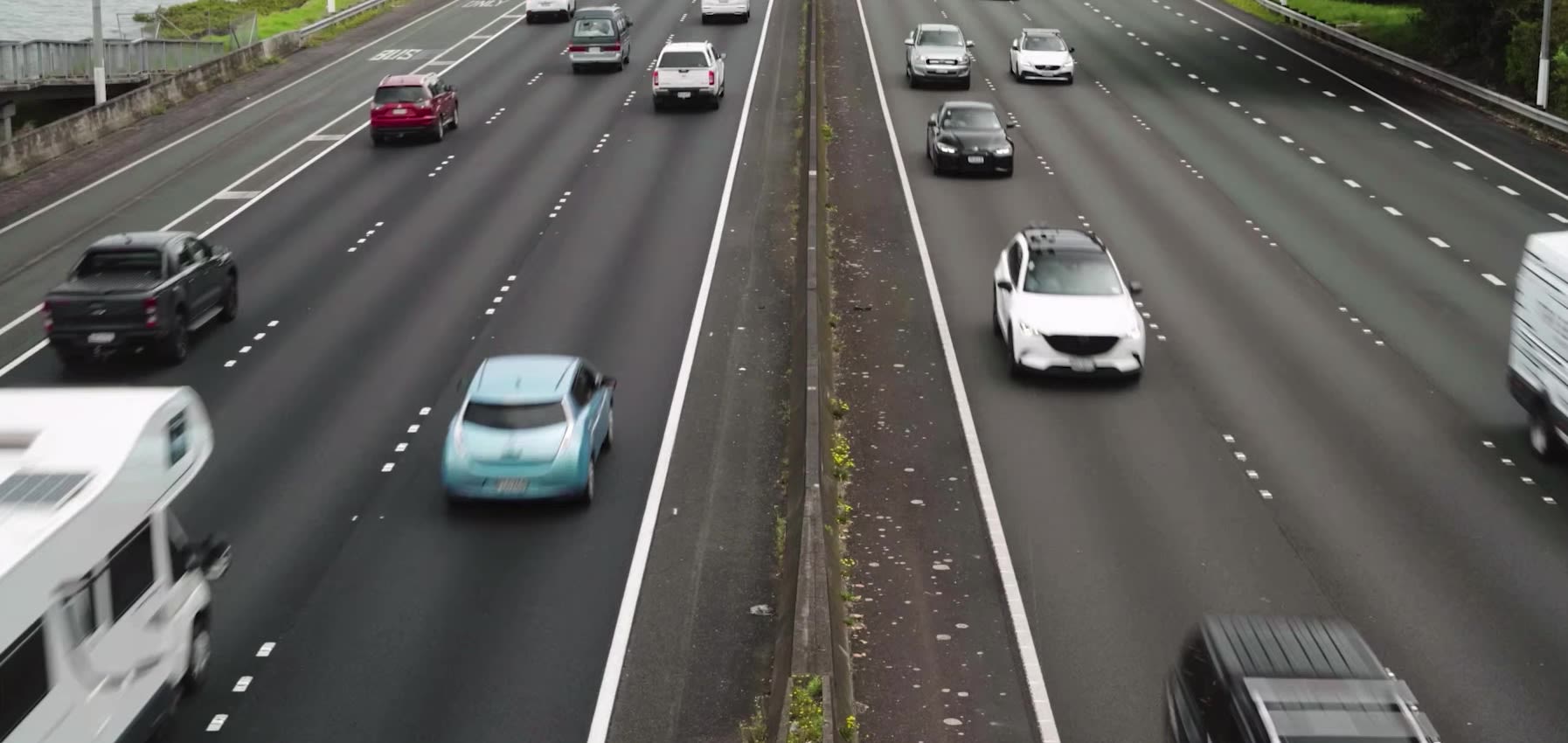
Phil Twyford was the minister in charge of air quality policy when the WHO standards shifted in 2021 and HAPINZ 3.0 was released last year, and was surprised by the dramatic findings.
“It’s been unrecognised, it has been a sort of silent killer. This is not some academic construct. This data is highly credible, so it’s a massive public health issue,” he says.
“My feeling about this is that the World Health Organisation standards and the HAPINZ report should be a big wake-up call for New Zealand. I think we’ve had this fond view that this country’s got its environmental challenges but we’ve always thought our air quality is really good. This data changes the picture completely.”
He points to the vast amount of work in the transport and climate portfolios which will see the number of diesel and petrol vehicles slashed over the coming decades. But he wasn’t able to say whether the WHO and HAPINZ findings would filter into a new round of air quality regulations.
The NES was last updated in 2004 and a 2020 review of the rules was postponed in anticipation of the new WHO guidelines. Now, those new limits are so strict they may not be feasible to enforce.
“WHO has set concentration limits for pollutants at levels that are very, very low – close to background levels,” Lou Wickham, a colleague of Kuschel’s at Emission Impossible, wrote recently in the Resource Management Journal.
“The scale of the air pollution challenge does not mean we need to stop driving cars, shut down industry and stop burning wood to heat our homes. But we should be clear-eyed about the impacts of the way we’re living.”
Twyford strikes a similar note in his comments to Newsroom.
“As a government, we also want to have some viable and credible solutions in place,” he says.
“It’s going to be quite a testing thing because you’ve got to take this data seriously. The cost and the mortality is staring us in the face. But I think it’s going to be quite hard to put in a standard that will form the basis of a compliance and monitoring system.
“If we’re going to set a standard, we’ve got to make sure that it’s practically possible for the regional councils to run a compliance and monitoring system. And because the new evidence shows that nitrogen dioxide principally from diesel vehicles in our towns and cities is such a massive contributor to mortality and public health risk – what do we do about that?”
The work also comes at a time of major upheaval in the resource management system. Any new NES will have to fit into both the current system and the new framework which will be implemented over the next decade. That means it could be years before a new standard with teeth is in place.
Peeni Henare, the current associate environment minister charged with air quality issues, says officials have no timeframe for completing the NES work.
There's more hope on the transport front. Those stringent Euro 6 standards for vehicle imported mentioned earlier are likely to be introduced in New Zealand over the coming years.
While Europe is set to move on to Euro 7 in 2025, the transport ministry hopes we can catch up shortly thereafter. The benefits could be immense – work by Kuschel building on the HAPINZ 3.0 findings suggested the increased cost of low-polluting vehicles required by Euro 6 would be more than offset by billions of dollars in health benefits.
Government has an essential role to play in dealing with this issue. Individual choices have a pretty limited impact on the chemical makeup of the air we breathe at home, on our commutes and at our workplaces. Where we live and where we work often aren’t up to us either and few people even have much control about how polluting our personal transportation is.
That makes the lack of urgency on new regulation even more surprising.
While transport policy will help cut pollution, the average dirty car imported today will probably still be on the road in a decade’s time. And wood- and coal-burners still caused an estimated 962 deaths, 3375 cardiovascular hospitalisations and 1435 respiratory hospitalisations in 2016, mounting a total bill of $4.6 billion to society.
This is a human problem, caused by the burning that has fuelled our societies. The solutions are human ones too. We know what they are, we know exactly how to catch this killer.
Every year we wait is another year of free rein for the invisible killer and another year’s worth of thousands of faceless victims, stacking up in hospital wards and school nurse’s offices, in intensive care units and in mortuaries.
As Kuschel says, we can’t un-know this. The killer has been unmasked. The next question is what, if anything, we’ll do about it.
